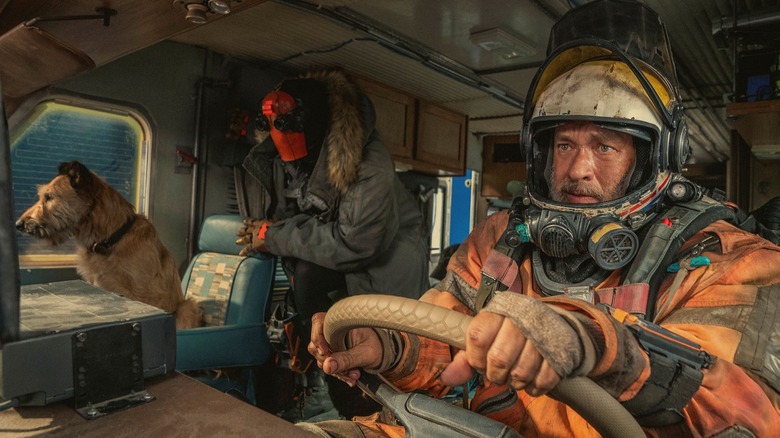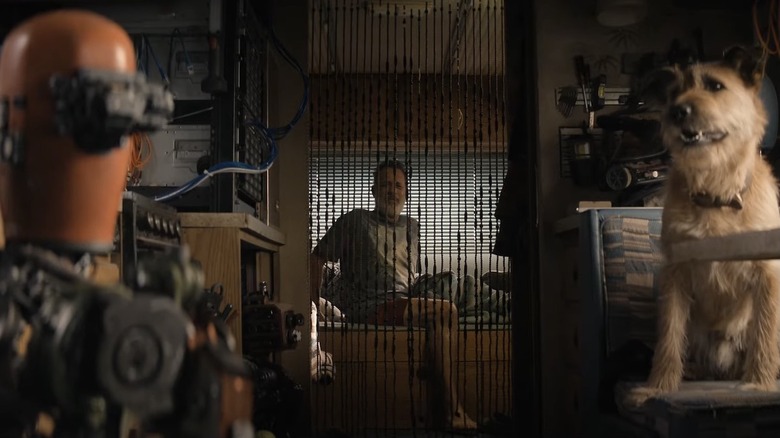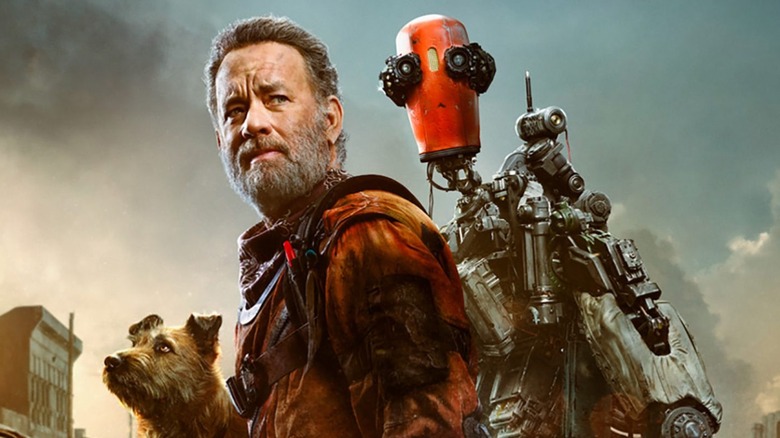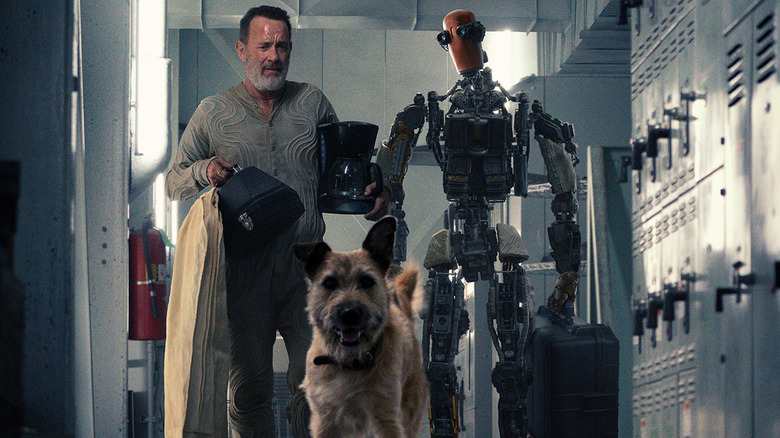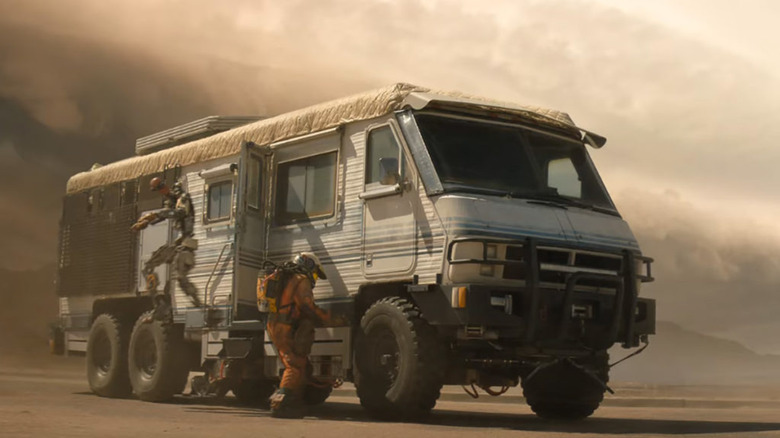Finch Director Miguel Sapochnik Didn't Want To Make A Science Fiction Movie [Interview]
Miguel Sapochnik is not known for light-hearted material. Over the past few years, the filmmaker has become most known for his episodes of "Game of Thrones," including "Battle of the Bastards" and "Hardhome." Now, the director behind those memorably grueling hours of TV has made, as he puts it, a family film. "Finch" is a road movie for adults, yes, but the original story of a man, his dog, and his robot has emotions and themes that'll play to a variety of ages.
Sapochnik, who previously directed "Repo Men," wants his second film to bring families together. "My biggest hope is that you, different generations can watch the movie together, father and son, or a mother and daughter," he told us. "It would be great if that could happen, because that's the conversation that I am most interested in being part of. I feel like we could learn a lot from our older generation as the older generation could learn from the younger one. If only we talked. Somehow there's this weird thing going on where we don't give enough credit to each other. I'm hoping we can find a way to come together in that respect."
Hope, too, is central to "Finch," a movie about coming-of-age and death. Recently, Sapochnik explained during an interview why he wanted to tell a story with more light than darkness.
Note: this interview contains minor spoilers for the film.
"We tried to tell the story in the production design, and it started with Jeff."
This is not a bleak, drained of color and life vision of a post-apocalypse. How'd you decide on the aesthetic?
I must admit, I spent a long time working on the script without ever really thinking about what it was going to look like. I didn't do that purposely. I was waiting for the right image to enter into my head to make me feel like I got it, that's this movie, that's this story. I had this idea that I talked through very clearly with Jo Williams, or DP, and with Scott Stokdyk, who was our visual effects supervisor, but it had evolved with Tom Meyer, who was our production designer. We worked for about a year and a bit on the design of Jeff.
I actually think about it aloud now that the design of Jeff influenced the look of the movie and in a way, so much of the design of the movie exists in its own little microcosm in the design of Jeff. For example, the hydrogen tank head that he has, which we had been looking for, how do we make a robot out of found objects? And one day, Tom sends me a photograph in an email, and it's a bunch of hydrogen tanks. They all have these cylinders on the top. Just underneath Tom said, "Jeff?"
I was like, I don't know what he's talking about. He wants Jeff to be a hydrogen tank? I'm not quite sure. And then suddenly, his idea became apparent, so we followed through with it. The hydrogen tanks, they painted them and repainted them and they're messy, not a clean finish. Usually, they paint them in really bright colors, and then they leave them in the sun for ages. And basically, they just get super faded. And that ended up being a really good example of what the world was, and that's where I guess "American Pie" comes from as well. It was this idea of Americana. Like, they go on this road trip and this movie, it's Tom Hanks with a dog and a robot.
And they go on this road trip to see the world and they go to a burger joint, and they go to a mall, and they go through a city and they fight the elements and they come up against a hurricane and they're in this old school RV. There are all of these aspects that we wanted to show that there was history here and everything used to be brightly colored. And then, this event happened and the color got washed away.
We tried to tell the story in the production design, and it started with Jeff. It evolved into the production design, but we were very keen to not end up with the same kind of color palette that you have seen in every post-apocalyptic movie. At the same time, you don't want to actively avoid it and you end up going in a direction that can be weird as well.
I remember the first conversation I ever had with Steven Spielberg, which was relatively nerve wracking. And then, he ended up being really easy to talk to. One of the things he said to me is, "What are you thinking about the color palette?" This was way back, and I really hadn't thought a lot about the color palette, so I said, "I don't know." I was honest, we all laughed, but I said," I really haven't got round to that yet." And he says, "You're not going to tint it all like you do in 'Game of Thrones', right?" And I said, "No, no, no." He goes, "Okay, good, good."
I think that the color palette should exist in the art direction. I took that very much to heart. And so even in the grading of the movie, we really try to stave off grading the movie in contrast to its actual color palette. I think that's why there's more color in the movie, because usually what happens is you have a more colorful image and then you desaturate everything and we try to avoid desaturating.
"...not a science-fiction film."
Since the aesthetic came later, what was your first impression of the script, in terms of how to best tell this story?
When I first read the script, I thought a lot about my daughter. Sorry, I should say I first read the script before my daughter was born, but when it first became a real project, as in I first realized, okay, this actually might get made. You've got all the projects you have in your mind, and then, you've got the ones that actually might get made, which are few and far between.
Once Tom got involved with the project, it had legs. I remember sitting down saying, "I need to read the scripts again." I knew I was going to go and have a meeting with him, so I read the script again. I found myself thinking a lot about my dad and a lot about my daughter, and that informed most of my thinking for at least the first 6, 7, 8 months of developing, not of prep.
Just from the process of thinking it through, I thought just a lot about the characters. I wanted Jeff to have the innocence that my daughter had, the curiosity that she has. I stole things that she says, and I put them in the script. Jeff says things that my daughter says, and I wanted Finch to have this aspect of my father, which is somebody who's very, very knowledgeable. Sometimes you are in awe of how much he knows. And other times, you realize that it could so easily become his undoing. Too much knowledge is not necessarily a good thing. I focused on that.
Gradually in its own time, the way that the film was going to look and style of it evolved. Primarily, the first thing that came out was that we were making a family drama and a road trip, but not a science-fiction film. The way that we were going to shoot the film had to reflect that. I think we took it a step further by deciding that we wouldn't try and recreate a family drama style, rather we would literally shoot it as a family drama, ignore all the visual effects aspects. Everything would be as if Jeff was really there. I think it gave everybody a perspective and a point of view and a beat to march to.
"...whatever you do, don't kill the dog."
Tom Hanks has to be one the most emotionally intuitive actors around. In that regard, how is he as a collaborator?
I think he's incredibly pragmatic about the way that he approaches stuff. It's an interesting process to watch. You don't quite know what he's going to do until he goes and does it, and then he's very open to taking direction and molding what he's doing and listening to what I had to say as a director. He'll adjust his performance when it doesn't feel right, looking for what does feel right, instead of reaching that point of, sometimes you'll find actors who reach a point of saturation where they feel like they don't understand what you want. They don't feel that you're articulating it correctly and they don't know what to do. They kind of want to move on. Tom didn't do that; he was very patient.
He wanted to find the answer. And so, when we hit the right tone for a scene, rather than try and then chase it too much, we would go, okay, we've got it. Now we move on. Because in a sense, one of the things that Tom is really good at is like, if he finds it, he nails it and you don't need to do multiple different takes.
You know from the beginning Finch is dying. There is something about watching Tom Hanks dying that's especially painful. Tom Hanks being Tom Hanks, did you know that would affect the audience?
Definitely. I was wary, and I love a good challenge. What happens if I take out one major movie star? Obviously, from a story perspective. We did a lot of tests at the beginning where we actually broke him down physically. He lost a lot of weight. We definitely reached a point where we were looking at some of the screen tests we had done, and we were like, we've gone too far.
There were moments where we pushed it so far where it's hard to look at, and even more so the fact that it's Tom Hanks. We need to pullback, because in a way, it was no longer servicing the story. It's not just a movie about dying. It's a movie about growing up, too, and so striking the balance, where it can both be dark, can have this bleak context, but also have hope and optimism in it, that was important. I didn't want us to hamstring ourselves by having a lead character who was so emaciated that it was hard to watch and hard to look at, but we tried it.
The other day, I was looking through some early stills that we had of the screen tests. I got to some of the ones where he's in a really bad way. I'm glad that we didn't go there, because it may have been scientifically accurate, but emotionally, it would've overpowered everything. You can't find hope at that point because as an audience member, you'd probably sit there and go, "You can't do that."
It is unconventional to not only kill your star, but also establish it in the beginning. Did you ever get a note, like, "What if Finch found a cure?"
I don't think we ever got the note that Finch had to survive. We definitely got in no uncertain terms, very, very strong notes that the dog couldn't possibly perish. And that was interesting because, again, the irony being, Tom Hanks is okay, but you kill the dog and you're in trouble. I thought that was always quite funny how strongly people feel about that. I had been warned on many occasions, whatever you do, don't kill the dog.
Was Jeff on the table? Was he an option to kill?
Everyone's on the table, man. I mean, let's face it, you've got to be prepared to kill your darlings. I think we made the right decisions in the end and made the appropriate decisions for the movie we're making for its audience. It's one of the most interesting things, I've made a lot of dark stuff. I've made a lot of really heavy stuff. "Finch" was a real challenge to maintain hope, for me to not go off to the dark side, not because I wanted to, but because hopes are much more amorphous and complicated and delicate and fragile things.
I realized through doing this movie, it's much easier to go to the dark side than it is to use a light. I mean, it really is. It's like, the dark side of the force is all about temptation, fear and jealousy, whereas the light side of the force is a different matter entirely.
"But this is a movie made for families."
How was the effect of Jeff accomplished?
He wore a displacement suit. He had these little kinds of bubbles on all the different joints so that we could track what he was doing. We tried to have the most unobtrusive version of motion capture when we were making the film. Specifically, because it's a complex and big technique. The reality is, it gets in the way of thinking about how you're going to construct a scene.
We somewhat, and this is 95% true, pretended it wasn't there. We certainly made a deal with myself and Scott, the visual effects supervisor, that we would not bring in a piece of green screen for the duration of the movie. Any issues that we were going to fix, we would fix later on. I think it was a good choice because it allowed us to think in very organic ways in terms of how we cover the film.
How do you feel about people watching the movie at home or, in some cases, maybe even on their iPhone or iPad?
I made this movie for a big screen and a collective audience. The movie is going to get a limited release, I think, in Alamo Drafthouses in America. Ultimately, there's a bigger issue going on, which is, how do you make cinema a financially stable, lucrative business when nobody's going? And then, it seems that people are going to very base things if it has action or if it's horror, you're still getting people in there.
But this is a movie made for families. It's not necessarily a family movie. It has adult themes. There's a dark aspect to it. It needs a slightly older audience, and that older audience currently is not going to the cinema. From that perspective, the platform of streaming and Apple, it will reach an audience far larger than it would have otherwise. One hopes that they won't watch it on their iPhone.
What made you want to tell a lighter story? Was it just where the world and your life was at?
All of the above. I think that having a kid fundamentally shifted my perspective on things, and I'd heard that happens and I didn't quite believe it, but suddenly, I'm responsible for somebody in a way that I've never been responsible before. I take that responsibility very seriously, so I need to learn about hope.
I remember not long after my daughter was born, I'd watch anything on the television. I mean, I'm talking like soap operas and stuff. If there was anything even vaguely emotional, I would start crying and I couldn't explain it. I realized that it was a good opportunity to listen to what was going on. Personally, I think this was a good time to try and make something hopeful.
I think on a global scale, in terms of where we are in the world and the audience that we're making it for, we've been living in a post-apocalyptic world it feels in some ways. We shouldn't ignore what's going on around us, but it is good to inject some hope and optimism into the world. I think I've injected my fair share of dark in there. So, it's about time I gave it back.
"Finch" is now available to stream on Apple+ and in select theaters.
